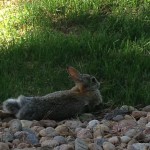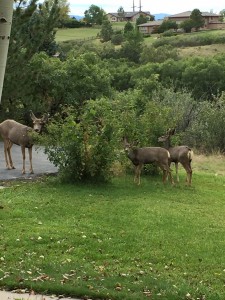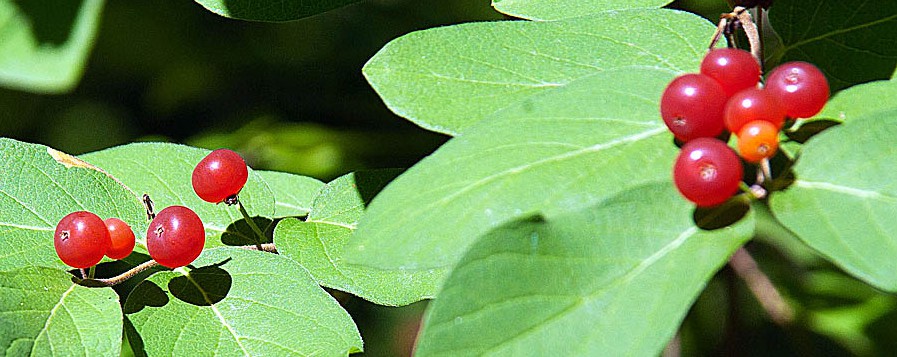No doubt, our most common wildlife neighbor is the rabbit, but rabbit habitat is coyote habitat. We see plenty of each in Charter Oaks. Although coyotes are nocturnal and would rather go unseen, residents in Charter Oaks hear them almost nightly and need only be a little attentive to catch a glimpse of one (or a few).
Each night at about sundown the coyotes come out of their dens for a little socializing and hunting. Attentive humans can observe them trolling our streets and arroyos on their ubiquitous search for dinner of rabbits and other rodents. The Colorado Division of Wildlife provided the video below to educate the state’s population about coyotes in urban environments.
Some interesting facts about coyotes–they:
- Mate for life;
- Are solitary (though they join forces during the winter to hunt more efficiently);
- Bear litters of one to 19(!) pups;
- Can run up to 40MPH;
- Will sometimes tiptoe to sneak up on prey;
- Are common throughout North America; and
- Live 10-14 years in the wild (longer in captivity).
Of course we see plenty of mule deer here too. They wander along our many ditches grazing on the indigenous grasses and laying in the cover of our plentiful scrub oak. Most of us enjoy seeing them–and they enjoy eating our flowers. It doesn’t take too long after you move here to figure out which plants and flowers are “deer resistant.” The elk rarely cross busy Castle Pines Parkway so we don’t see them often in Charter Oaks, but we still enjoy them in nearby Daniels Park closer to Castle Pines Village.
Here are a few facts about the mule deer:
- They don’t have any upper teeth, only hard palate;
- Their hair is hollow allowing them to stand our cold season better;
- Some does grow antlers, too;
- Their habitat ranges from desert to mountains to chaparral and to the plains;
- A bounding mule deer can jump up to 15 feet;
- Their big ears help them hear, but they have a 310° field of vision.
The coyote is the mule deer’s natural enemy. But in the fields and valleys near Charter Oaks, the deer have another concern–bobcats. The habitat supports both lynx and bobcats, as well as foxes. And homeowners have reported frequent and repeated sightings of all three. There are a variety of other animals lurking around in our underbrush, too. Raccoons and porcupines aren’t uncommon. Several residents in Charter Oaks and in Beverly Hills to the east have reported seeing a black bear. One resident had video footage of him (or her?) playing/bathing in a birdbath and not only once–that bear was a return visitor!
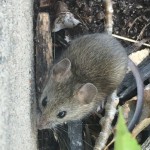 Rabbits aren’t alone as the prey, either. This part of Colorado is home to several small rodents (voles, moles, pocket gophers, squirrels, mice, and so on) all of which we see regularly in and around our yards.
Rabbits aren’t alone as the prey, either. This part of Colorado is home to several small rodents (voles, moles, pocket gophers, squirrels, mice, and so on) all of which we see regularly in and around our yards.
Those are only a few of the animals we see here. There are turkeys. There are majestic owls. And part of the year we are likely to encounter more than one species of snake. Red-tailed hawks and peregrine falcons are as common as ravens and magpies. We evan have a bald eagle that flies over every so often.
The Charter Oaks Owners’ Association admonishes visitors and residents alike: enjoy wildlife from a distance. And never feed them. They cohabitate with us, but they aren’t pets. Feeding the animals allows them to lose their healthy distrust for humans. It also causes them to become lazy and abandon their natural instincts to hunt or forage…and why not if someone is offering free kibble. When they become lazy and dependent on humans, they are at increased risk for disease, malnourishment, predation and many other hazards. It’s not good for us or for our wildlife, so once again, please enjoy them from a distance.
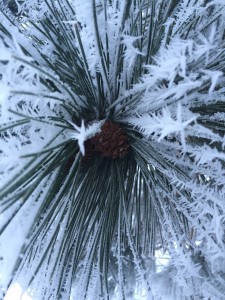 The animals thrive here because the area is so rich with the right environment. We are happy (and lucky) to live in the West where we have such beauty all around us.
The animals thrive here because the area is so rich with the right environment. We are happy (and lucky) to live in the West where we have such beauty all around us.
Before the Pikes Peak Gold Rush, this area was more heavily forested than today. A lot has changed in 150 years. The rapid growth and building in Denver during and following the gold rush created high demand for lumber and other raw materials. Much of those materials came from here. The resulting deforestation left ideal land for farms and ranches and the topography we are familiar with today.
Bristle Cone Pines, Rocky Mountain Juniper, and of course Colorado piñon, all native trees, are seen throughout Charter Oaks and the surrounding area. Naturally they’ve been augmented today with a variety of other evergreen and deciduous trees used for landscapes and decoration.
Many of the plants here not only provide sustenance and habitat for the animal life, they are useful as food for people too. Yucca plants can be found on nearly every homeowner lot in Charter Oaks. The yucca is hardy to the point of being stubborn. Aboriginal Indians had many uses for it. Its flowers are edible as are its roots. Ute Indians, known for their basket-making prowess, used the yucca’s leaves to weave beautiful and utilitarian baskets and vessels. And they didn’t stop with baskets, but they made sandals, mats, and other useful products. They also wove its fibers into ropes and lashings. Indians and white settlers used its root to make soaps (some people still call it”soap weed”).
Another edible plant that grows here is the yampah. It was once known as the “Indian carrot” because the best food part is its root. But it’s a relative of parsley, and the whole plant can be eaten from its flowers and seed to its root. The root is said to have a chestnut like texture and a nutty quality. Traditionally it was roasted, steamed or boiled. Raw, it was used as a laxative medicine.
